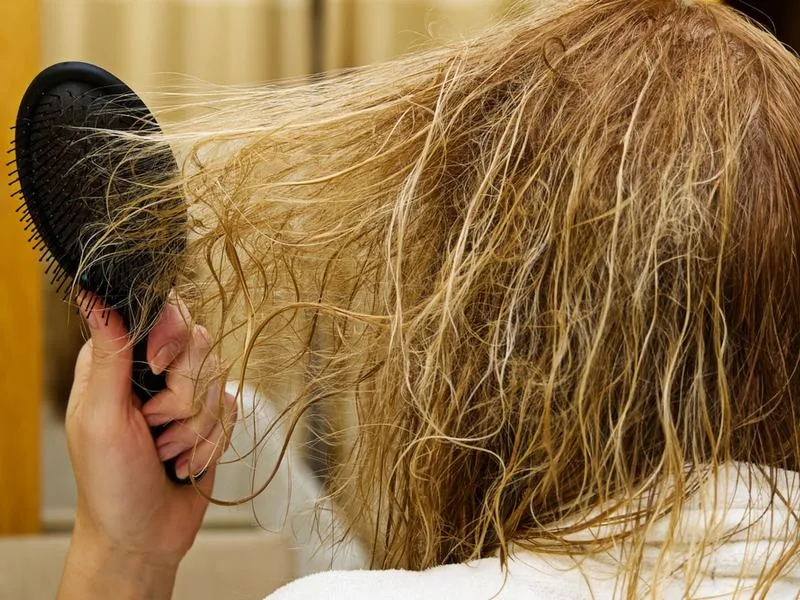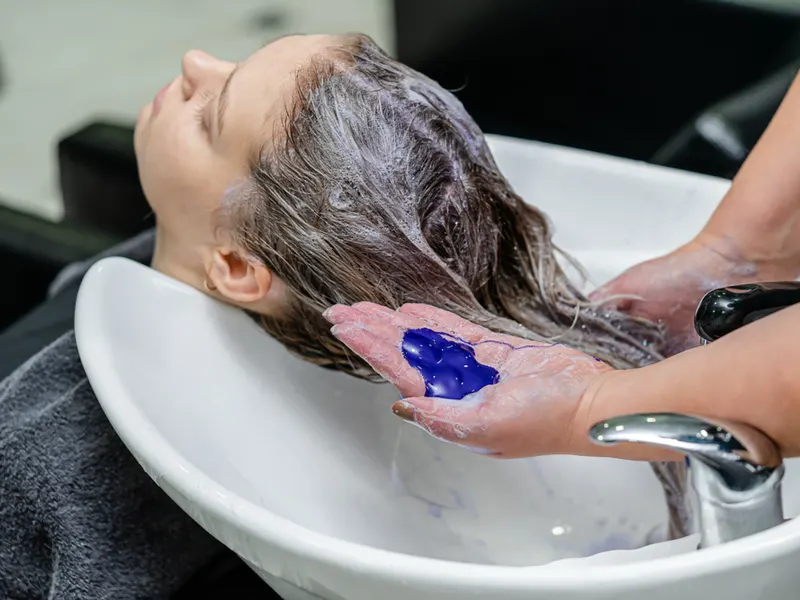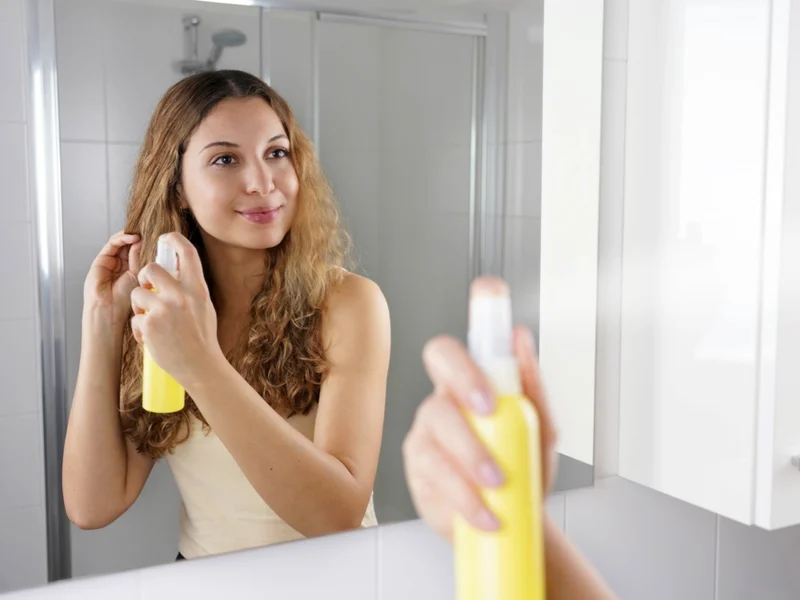Jump to:
Hydrogen peroxide is one of the most popular, inexpensive ways to lighten the hair but can result in bad peroxide hair. Sometimes the effect is uneven, leaving the color patchy or orange, and leads to damage of hair cuticles.
Fixing Bad Peroxide Hair: A Summary

VidEst/Shutterstock
You can fix bad peroxide hair by moisturizing, avoiding heat styling, and re-coloring the hair if it’s brassy, orange, or uneven. There are several things you can do to fix bad peroxide hair, including:
- Wash your hair less frequently
- Avoid hot water
- Use more conditioning products
- Let your hair dry naturally
- Avoid hot tools
- Avoid sun and chlorine
- Use a purple or blue shampoo
- Visit a salon
- Try balayage
- Get a trim
If you have bad peroxide hair, you owe it to yourself to try one or more of these tips to fix it. Taking care of your hair now at its most vulnerable can prevent future hair loss, breakage, and damage.
How to Fix Bad Peroxide Hair Dryness in 6 Steps
Hydrogen peroxide dries out the hair and can leave it frizzy, rough, and prone to breakage. The way it strips color from hair can also leave an undesired look. The key to repairing the dryness is to add as much moisture as possible while avoiding anything that can dry hair out even more.
1. Wash Your Hair Less Frequently
If you’re used to washing your hair every day, stretch it out to once every three or four days instead. Bad peroxide hair has been dried out too much by the peroxide. Letting the natural oils on your scalp accumulate can help fight this drying effect.
2. Avoid Hot Water
Heat is your hair’s enemy after damage from peroxide or other bleaching treatments. When you wash your hair, use water that’s as cool as you can stand.
The hotter the water is, the more oils it will strip away, and the more it will contribute to your hair’s dryness. You don’t have to wash in cold water, but room temperature, lukewarm, or cool water is better for your hair.
3. Use More Conditioning Products
Condition your hair frequently. Various hair conditioning products can help add moisture back into the dry strands of bad peroxide hair. If you’re used to only conditioning your hair after shampooing it, you’ll need to add more steps to your hair care routine.
Moisturizing Shampoo
If you don’t already use a moisturizing shampoo, switch to one. These shampoos have moisturizing agents that help reverse the dryness caused when shampoo strips away hair’s oils.
Leave-In Conditioner
You can use a conditioner in the shower, but those conditioners only leave moisturizing ingredients outside the hair. A film remains, but that disappears pretty quickly as the hair dries. Use a leave-in conditioner you put in the hair while still wet.
Leave-in conditioners don’t get rinsed away, so they help trap moisture inside the strands. This conditioner works better than the conditioner meant for use after shampooing.
Deep Conditioning Treatments
Once or twice a week, use a deep conditioning treatment to help fix your bad peroxide hair. Hair oils, creams, and masks all work essentially the same way.
You coat your hair with the product and leave it on for the time their manufacturer recommends before gently rinsing it away. Continue to use a moisturizing shampoo and leave-in conditioner when you wash your hair.
But using specialized moisturizing products once or twice a week will further moisturize bad peroxide hair and help it look better faster. Products that contain keratin can help seal the cuticle to retain moisture and improve hair’s texture and shine.
4. Let Your Hair Dry Naturally
Blow dryers, mainly when used with high heat settings, contribute to dry hair and scalp. Just using a blow dryer frequently can cause heat damage. When your hair is already dried out because you bleached it with peroxide, applying hot air to it will worsen the problem.
After using a leave-in conditioner, let your hair dry naturally. If you need it to dry faster, pat the hair with a dry towel. Don’t rub or scrub the towel on your hair but blot it gently. If you must use a blow dryer, use the coolest setting possible.
5. Avoid Hot Tools
Along with blow dryers, styling appliances like crimpers, flat irons, and curling irons help you style your hair, but the heat does damage hair over time. Applying heat is a bad idea if you have damaged bad peroxide hair.
Any crimping or curling can result in breakage, which will only make the texture of the hair worse. Style your hair gently and opt for styling tools that don’t rely on heat, like curlers that you put in slightly damp hair and leave to dry.
6. Avoid Sun and Chlorine
Sun and chlorine can damage hair separately, but they’re like a one-two punch against your hair when combined.
Sun
Sun lightens hair and has a drying effect. Over time, the sun’s rays will damage hair’s cuticles. Hair that has already been damaged and dried out needs protection from the sun. Even healthy hair can benefit from sun protection.
You can purchase products that have SPF ratings to use on your hair like you would use sunscreen on your skin. Stay out of the sun as much as possible, especially during the peak sunlight hours of early to mid-afternoon. Wear a loose hat or scarf to cover your hair when you have to be in the sun.
Chlorine
Chlorine is a chemical used in swimming pools that has an extreme drying effect on hair and skin. Indoor and outdoor pools contain chlorine. Indoor pools have a higher concentration of chlorine, but swimming outdoors exposes your hair to chlorine and sun at the same time.
A swim cap can keep your hair as dry as possible and protects against sun and chlorine.
If a swim cap is out of the question, wet your hair before swimming. Afterward, immediately wash your hair in a moisturizing shampoo and condition it to remove any lingering chlorine and counteract its drying effects.
Read Next: How to Fix Gummy Hair After Bleaching
How to Fix Bad Peroxide Hair Color in 4 Steps

Tetiana Tychynska/Shutterstock
Sometimes bad peroxide hair isn’t just dry and brittle, but the color doesn’t look like you’d hoped. Hair can have an orange tint or look completely orange, and the bleaching effect can be patchy and uneven. Here are a few tips to try to help counteract these problems.
1. Use a Purple or Blue Shampoo
If your hair turns out brassy, as bleached hair sometimes does, purple shampoo can help. When the color is more orange, a blue shampoo might work better.
You can try one or both to see which improves the look of your hair more. The blue and purple color cancels out the yellow and orange to cool down the tone and minimize yellow and orange in your hair.
2. Visit a Salon
Anytime you bleach your hair and feel the need to re-bleach it to try to even out the color or go a shade lighter, you have to wait at least three weeks to let the hair recover before you attempt it. However, it’s never a good idea to re-bleach hair, especially bad peroxide hair that is damaged and dry.
Fixing bad peroxide hair that’s yellow, orange, or patchy can be as simple as having the hair professionally colored. You can dye your hair at home, but there’s a decent chance that the new color will turn out patchy too.
It might not take as well on more damaged parts of your hair. A professional stylist understands the chemical reactions of hair products and can make a recommendation about the best way to fix bad peroxide hair color.
Color corrections or a new darker color is typically the best course of action. Go to a salon you trust and explain that you used peroxide so they can choose the best products to use to counteract its effects.
3. Try Balayage
Balayage is a hair coloring technique that involves coloring only part of the hair. Unlike normal highlighting, color is placed on the hair randomly and looks less uniform. This technique can help camouflage patchiness by creating different shades and colors in the hair that look more natural.
4. Get a Trim
A haircut to trim away split and dead ends can improve the texture and overall look. If your hair is long, a shorter haircut won’t improve your hair’s health or fix patchiness, but it will make your hair look neater and make it easier to manage.
Frequently Asked Questions

Zigres/Shutterstock
Here are answers to some frequently asked questions about bad peroxide hair.
Does peroxide damage hair permanently?
Hydrogen peroxide’s color-stripping effect is permanent. The only way to change the hair color after applying peroxide is to let it grow out or dye it. The damage peroxide causes inside the hair is also permanent, but conditioning it often can help counteract the dryness.
What happens if you put peroxide on brown hair?
Peroxide applied to brown hair, especially on darker brown shades, can turn the hair orange. If you’re determined to try peroxide, apply a small amount to a hidden patch of hair to see how it turns out before you use it.
Will peroxide turn gray hair blonde?
Some people successfully use hydrogen peroxide to remove yellow tones from their gray hair. A better and less damaging solution is to use a purple or blue shampoo.
A professional coloring is also a better choice because hair dyes and other products don’t always react the same to gray hair as they do to blonde or brunette hair.
What’s the best dye to use for patchy bleached hair?
Dyeing your hair at least one shade darker can help camouflage bad peroxide hair. Attempting to bleach it more to get an even light shade can contribute to dry and brittle hair. Covering it all with a darker shade has the highest chance of success and will be less damaging to your hair than any bleaching product.
Can you fix over-processed hair?
Sometimes hair is so over-processed, bleached, and chemically treated that there’s nothing you can do to repair it. Using the tips above will help improve the general look and feel of the hair, but you can’t reverse the damage. Let the hair grow and trim the damaged ends to replace brittle hair with new, healthy growth.
So, How Do You Fix Bad Peroxide Hair?
By being gentle with your hair, moisturizing, and avoiding things that can damage it, like heat, sun, and chlorine, you can improve the look and feel of bad peroxide hair.
Purple or blue shampoos, a trim, or a new dye job can cover over bleached, brassy, or patchy hair to give you a more uniform look.
